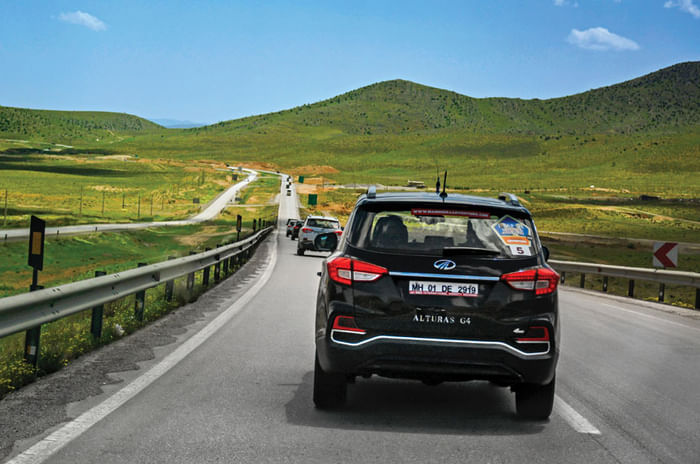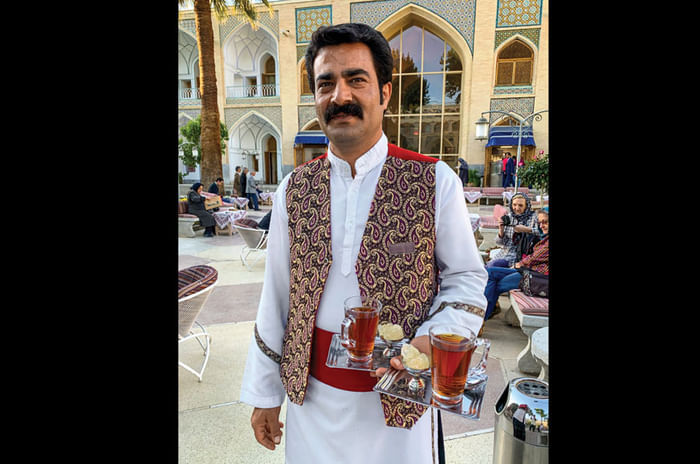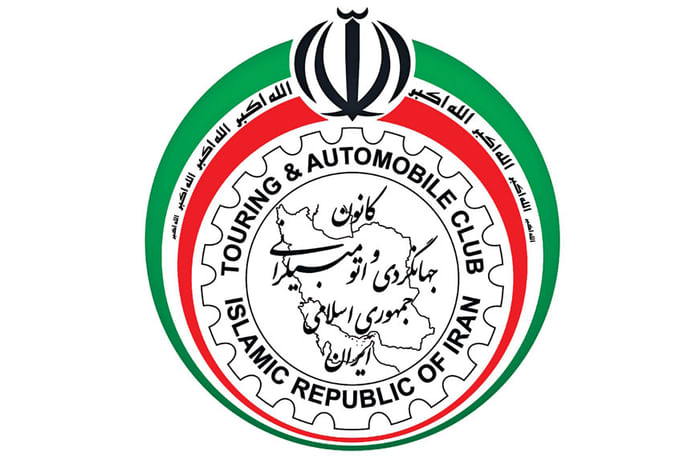Iran. The first time there didn’t work out so well for me. En route to Mumbai from Istanbul in 2009, our Turkish Airlines 767 made a long U-turn over the snow-clad Alborz mountains and made a wobbly touchdown in Tehran, the left engine sputtering like an exhausted marathon runner. I won’t bore you with the tale of how Turkish made us board the flight again after 18 hours, only to have us land back in Tehran with another engine failure. But what the 40 or so hours spent in Tehran’s Mehrabad airport, talking and chatting with the locals did was make me promise myself I’d be back. Why? Strangely, and completely against expectations, the Iranians I met seemed pleasant, laid back, a lot of fun and even extremely proud of their non-Islamic heritage. Iran, a land so close yet so far . . .
Fast forward a decade or so and I’m back in Tehran, but this time with a visa in hand. In addition, I’m not just here to visit the city; I’m here to drive the length of the country with 24 intrepid travellers and six Mahindra Alturas SUVs. Interestingly, our lead car is a Mahindra XUV500 imported in 2017 by Azim Khodro, one of Iran’s largest auto companies, which had tied up with Mahindra to sell its SUVs in Iran. However, Mahindra’s plans to expand into the Iranian market hit a road block after the US reimposed sanctions on Iran.

Now the question is, what surprises will this ancient land throw up? Will it be different from the myriad Arabian states that dot the region? Will it prove to be a curious blend of old meets new? Will the Islamic state dominate life and lifestyle? And, importantly, will we still be able to feel the remnants of the state that, back in 550BC, was one of the world’s first superpowers, one with a liberal attitude to one and all, and a sharp focus on multicultural tolerance?
Tehran in the north gives us our first taste of Iran, and to put it mildly, it comes as quite a surprise. Situated in a valley with tall snow-clad mountains towering over it even in summer, Iran’s capital has natural beauty, charm and depth of culture that all but smack you in the face. Our tall 20-floor hotel that’s situated on the foothills of the mountains gives us a panoramic view of the Alborz. The city is dotted with many gardens and parks. Tall Cypress trees line the roads and the intracity four-lane roads are so wide and widespread, they remind me of the ones in Dubai; makes me wish our cities had roads as free-flowing and well laid out. The people here are incredibly friendly, helpful and make you feel immediately at home. Engage them in a friendly chat and they soon prove to be very charming, progressive and open to discussing just about anything. And what adds considerably to the appeal of the city is that the streets are clean and nicely spaced out. Not much is really in your face, and that sort of gives you a lot of ‘breathing room’.

Our tour of the city includes an in-depth look at the Golestan Palace, a world heritage site. A complex of several palaces, Golestan has been the residence of the ruling monarchs of Iran since the 16th century. And the last of the palaces was built as recently as the ’60s. One of the highlights is ‘The Brilliant Hall’, a stunning room of mirrors built by the Pahlavi kings in the ’60s. And no visit to Tehran can be complete without a visit to the Azadi Tower. From afar, this gateway looks a bit too ambitious when it comes to the design, but walk up to it and its full majesty just smacks you in the face. The massive structure actually seems to change shape and transform as you get closer. And then there’s the fascinating and complex insect eye-like underside that’s not to be missed.
Convoy rolling
Our journey leads us south next, and, for the first time, we get to open out the Alturas on Iran’s wide open highways. And boy does it feel at home holding on to triple-digit speeds! The wide three-and four-lane highways here are mostly traffic-free (by our standards), and with speed limits set at 120kph, we are able to cruise with ease. What impresses is that both the sides of the highway are often separated by a distance of 50m or more, and what adds to your peace of mind is that most are well-lined and surfaced as well. No, the highways aren’t as billiard-smooth as those in Dubai or Abu Dhabi, with the odd rough patch or bump popping up every now and then, but the wide expressway lanes do allow us to enjoy a relaxing drive.

Now driving in a convoy isn’t every petrolhead’s dream, but what keeps things interesting for us is that we are the sweep/camera car, and this allows us to run up ahead to take a shot, fall back and then play catch up again. What makes our day-long stints behind the wheel so comfortable and what endears us most to the Alturas is the focus on comfort. Those ample leather seats are super-supportive, the seats up front are even cooled, and then the car is near silent on the move because of the smooth diesel engine. The ride is also supple, absorbent and mostly devoid of the lumpiness associated with heavy body-on-frame SUVs. Yes, the overtaking ability is a bit blunted, as the 181hp engine is a bit overwhelmed by the payload of four passengers and their luggage.

What makes driving on the highway even more spectacular is the topography. As soon as we head south from Tehran, it’s almost like our horizon expands massively . . . there’s just nothing but scrub and low bushes for kilometre upon kilometre. And what makes us stare slack-jawed at the majesty of the landscape, is the scale and the breath of the canvas. No trees, no dense undergrowth, only desert stretching as far as the eye can see on either side. To our left, the simply massive Kavir and Lut salt deserts, and to our right, at a distance of around 100km, the 4,000m snow-clad Zagros mountain peaks glistening in the harsh sunlight. It sometimes feels like we are on another planet.

Our next destination, Isfahan, is approximately 450km south, and nestled in the foothills of the Zagros mountains. Once the capital of Iran, it is an impossibly charming city and one with a layout that’s very different from anything else experienced. Crisscrossed by canals, even through residential areas, it is a city that gives you the feel of a desert oasis and an upper-class suburb, all at the same time. And what makes it quite unforgettable is that it has some unique architecture, like the 300m-long Si-o-Se-pol bridge that is a superstructure of arches built over its 33 spans, ostensibly for protection against cold wind and snow. Then there’s one of the largest squares in the world, the stunning half-kilometre-long (560m to be exact) Naqsh-e-Jahan that’s built in the style of a caravanserai. And then there’s the Armenian Vank Cathedral that shows off Iran’s multicultural past and all but has the entire Bible illustrated on its walls on the inside. In fact, Isfahan’s cosmopolitan character was something you just couldn’t miss; this, after all, was where the Persians allowed the persecuted Jews to settle, where Zoroastrianism flourished, and where Cyrus the Great famously put his famed religious tolerance into practice. Even the hotel we stayed at was historically significant. Known today as the Abbasi, it was first built as a caravanserai around 300 years ago, and still has the same layout.

Different dimensions
This is also about the time we discovered the Iranian kebab or Koobideh. Made of grilled minced lamb, you can all but smell it when you enter a restaurant. Often served with saffron-infused rice, grilled vegetables and plenty of butter, it is something we enjoyed for two weeks on the trot. What we were also keen to dig into was the biryani. The Iranian version, however, turned out to be quite different. To begin with, there was no rice, only lightly ‘burnt’ mutton and liver in a small crucible, accompanied by a massive roti. “Indian biryani has rice in it,” said the locals. And the other thing we all dug into our pockets and purchased were carpets. Converting Iranian rials to rupees was intimidating. Google wasn’t very useful as the official rate differed greatly from the rate on the street. And then, we had to factor in all the zeros and hand over piles of cash. After all, 2,000 Iranian rials is equal to one rupee. It doesn’t take much to be a billionaire here! And what also helped hugely was the fact that we could carry all our carpets with us, with the big 872-litre boot of the Alturas swallowing all our luggage.

While most of us in the group were Parsis or Zoroastrians, it was only at the Chak Chak caves, 310km out of Isfahan, that we came across the first trace of the religion. Situated in the middle of nowhere, the cave is where – legend has it – a gap in the mountain and a spring miraculously appeared and hid a fleeing Zoroastrian princess, saving her from the invading Arab army. ‘Chak Chak’ is the sound of the perpetually dripping water . . . that now drips directly onto the floor of the fire temple built at the spot.

Our next stop was the ancient city of Yazd. We made a halt at another Zoroastrian landmark, the only Atash Behram outside India. A type of fire temple that enjoys an exalted status due to how the holy fire has been consecrated, the Atash Behram fire at Yazd has apparently been burning for 1,550 years. While non-Zoroastrians aren’t allowed into a fire temple in India – due to the promise we made in India not to convert – the one in Yazd was teeming with tourists. The vast majority were Iranians who’d come to ‘see a part of their heritage’, and meeting them and introducing ourselves as people of Iranian origin ‘once removed’ felt pretty other-worldly. However, truth be told, far from feeling like the ‘Vatican’ or ‘Mecca’ of Zoroastrian holy sites, the Atash Behram was somewhat of a disappointment and felt quite ordinary.

After our visit to the holiest of sites, our next stop on the outskirts of town was the Tower of Silence, where Zoroastrians leave their dead to be consumed by scavengers like vultures. These sites are normally off limits in India, as they are mostly still in use. But here, with the practice now outlawed and the site unused, we got a quick peek inside. And, as expected, it was as eerie as anything I can remember; and that’s with the hard desert sun shining down on us. The sight of the disc-shaped, stone-lined pan, surrounded by barren mountains on all sides is just etched in my memory.

It wasn’t just the architecture, Iran also impressed when it came to engineering. Case in point, the ‘Bad-Girs’ or wind catchers – structures engineered to increase the speed of air flowing through it to cool it. Iran’s buildings that use wind-catching towers often also have large domes and a water source, placed down low, that further help increase air speed and lower temperature, with the use of convection as well as evaporative cooling. A drop of 15-18 degrees is not uncommon.
From Yazd, our caravan led us straight to the ancient Achaemenid capital of Pasargadae. Built by Cyrus the Great, the founding father of the dynasty, the site contains his tomb as well as a set of palaces, widely spaced out in what was a massive garden back then. The tomb is very simple in construction, but seems to have been very intelligently engineered to withstand the ravages of time. And the fact that it is the only building that’s intact from that age in Iran is proof enough. The base is wide and built of massive blocks of white limestone, each seemingly immovable. And above this is the simple tomb room, also made of blocks of stone and tree trunks split down the middle to provide the flexibility needed for it to stand. The story is that Alexander the Great stopped here to pay his respects to Cyrus, who he greatly admired for his tolerance, after having finally defeated the Persian army. He apparently also ordered no harm come to the structure, in line with Cyrus’s plea: “Grudge me not this piece of land on which I’m buried”. . . or some such.

Whereas Cyrus’s tomb at Pasargadae is simple, solid and had an indestructible air to it, the new capital of the empire, Persepolis, could not be more different. Grand in scale and brilliantly conceived, it seems to be floating above the surrounding area on a massive plinth. You climb up through what is called the ‘Gate of all Lands’; the empire was a federation of many nations, each with their own cultural traditions and national identity intact. And then what gets your imagination fired up in the audience hall ‘Apadana’ is the bass-relief that shows a whole line up of emissaries, with tributes from each of the 23 ‘nations’.

Persepolis, of course, was sacked by Alexander (‘the accursed’, as he is known in Iran) and most of it was burnt, some say in revenge for the Persian burning of Athens in 480BC. That’s one version, at least. Alexander, of course, is thought to have met his end after a close encounter with an arrow, fired off a 2m-long Indian longbow, somewhere in Sind, the next country he tried to conquer. The high-speed arrow pierced his armour and then punctured his lung. Seriously wounded and on the retreat, he died of a fever in Babylon.

India and Iran aren’t that far off, after all. Iran, in fact, now gives Indians a visa on arrival and you can either fly direct or via Dubai. Yes, ladies have to keep their head covered and, of course, alcohol is banned, but the next time you think of going to an offbeat place, consider Iran; it certainly isn’t what you think it is.
A driving holiday in Iran?
It’s not as crazy as it sounds and here are five reasons why
Papreless visa on arrival
Indians can now get a visa on arrival and immigration is a breeze. Also, there’s no stamp on your passport, in case you’re worried about being questioned on your next trip to the US.
It's cheap, cheap, cheap!
With the economy in shambles, the Iranian rial is at an all-time low. That’s hard for the locals but great for tourists. Car hire, hotels, food, tolls, admissions are all dirt cheap. And petrol at the equivalent of Rs 9 per litre is as good as being free!

Google maps works
You would have thought any tech that’s American would be banned here, but surprisingly, Google Maps works. It’s best to get a local SIM card, which comes with really cheap data packages.
Great road network

People love to drive here. In fact, the best way to get around is by road. The highway network is fantastic, with signage in English, and you are surrounded by some spectacular scenery even on the main routes. The highways can get bumpy but they are wide and don’t have much traffic.

It’s safe to say that Iran is, well, really safe. The people are honest, friendly and helpful, which overcomes the language barrier to a great extent. The only thing scary about this country is the way people drive. It reminds you of India!
TACIT Approval
Cars and driving is in the culture of the Iranian people. Even the last Shah of Iran was a huge car buff and his fantastic collection is now part of the museum in the Sa’dabad Palace Complex in north Tehran. Motoring took an organised form in Iran, with the formation of the Imperial Touring and Automobile Club of Iran in 1935.

After the Islamic Revolution in 1979, it was renamed the Touring and Automobile Club of the Islamic Republic of Iran (TACI), but its activities have remained unchanged. It continues to offer a wide range of services to not just Iranian motorists but also to foreign tourists travelling in their own vehicles. TACI has represented Iran at the Federation Internationale de l’Automobile (FIA) since 1952. “Our main objective is to provide services for road travel and make it as comfortable and easy as possible,” says Mehdi Alamdar the head of international affairs, TACI. In fact, without TACI and its associated agencies, this drive would not have been possible. This quasi-government organisation proved to be an incredibly efficient single window for all the necessary permits and documentation needed to allow six Alturas to be driven in Iran. “We want people to know how easy it is to drive in Iran,” says Alamdar. Hard to believe but that’s absolutely true!
Also playing a pivotal role in the smooth running of our Iran drive was Captain Aftab Ahmed Khan, the dynamic defence attaché in the Indian Embassy in Tehran. It was Captain Ahmed who introduced us to TACI and gave valuable suggestions for this unforgettable road trip.
For more images from our 10 day journey, check out this comprehensive image gallery











































